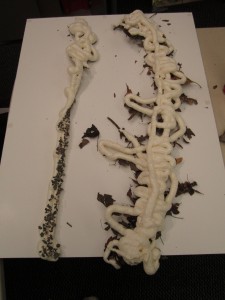Skipping Homes | Throwing Rocks | Bucolic Building
September 19th, 2012 By NOTAndrew QuitmeyerI propose a relaxing, non-teleological system for throwing rocks and creating unique construction materials. For the human the process will be: first skip/hurl stones into a lake, stop whenever, then finally assemble together the resulting uniquely shaped logs.
Setting: Quiet lake-shore strewn with rocks, pebbles, dirt, sand, leaves and twigs
1) Ubiquitous skill/ play property; Throwing Rocks
Throwing rocks into water, or the slightly more advanced process of skipping stones, is a meditative rewarding process. My design seeks to incorporate the whole of this process with minimal digital intervention. Thus the person will perform all aspects of stone skipping as if the digital device did not exist.
Scan the shore for choice rocks. Dig up rocks with your hands. Weigh, compare, absorb the information of the stone. Fling the rock towards the water. Visually and Aurally connect with your object during its brief, flaming period of life. The feedback from the rock’s performance is incorporated into your body and encourages further throwing in order to validate the newly learned information.
Throwing rocks is enjoyable because it constitutes the the core function of intelligence and learning: continuous analysis of prediction.
2) Digital Analysis
There will be one, minute change to the typical stone skipping process. Before flinging, the human will attach a thin strip of reflective tape to the rock’s edge. This is the only interfering component of the system. Next to the human, on the shore will be a smart phone whose camera is facing over the water. The camera has a small peice of infrared filter over the lens. An infrared flood lamp sits next to the phone, also directed over the lake. When the rock is thrown, the mirrored strip will beam pulses of information back to the camera lens. The stone’s relative position, velocity and spinning frequency can be determined through non-difficult computer vision methods. The splashes will also probably reflect the infrared radiation in a manner which can help the system collect more information about the flight and its aftermath.
3) Digital Exploitation of Ubiquitous Skill for Production: Strut Casting
Tethered to the computer vision system is a simple two-axis pivoting head which controls a spray nozzle. The head’s orientation and spray will be controlled by the information collected through the camera. The substance sprayed will be a thin line of a foaming, bonding agent that rigidly hardens within seconds or minute. Ideally this substance would be a biodegradable version of Dow’s “Great Stuff” foaming sealant. The rigid lines would be cast directly onto the surface of the beach forming dirty logs which physically incorporate the environment. Every stone tossed generates a new line. The user can keep throwing logs and the system will keep squirting onto the previous log, making it thicker and thicker. Whenever she wants, she can kick (or dig) the generated strut out of the way.

The exact material for the rigid foaming substrate is not totally fleshed out yet, but here are some biodegradable / bioincorporative alternatives to Dow’s Great Stuff:
Plastic make from milk and vinegar (takes two days to set): http://www.instructables.com/id/Homemade-Plastic/step3/Strain/
Robot makes sandcastles: http://www.futuredude.com/stone-spray-robot-makes-sand-castles-last-forever/
4) Construction
At the end, the user gathers her generated logs and uses them to assembled a shelter for the night, or (if the rigid foaming substrate works out) a raft for traversing the lake.



